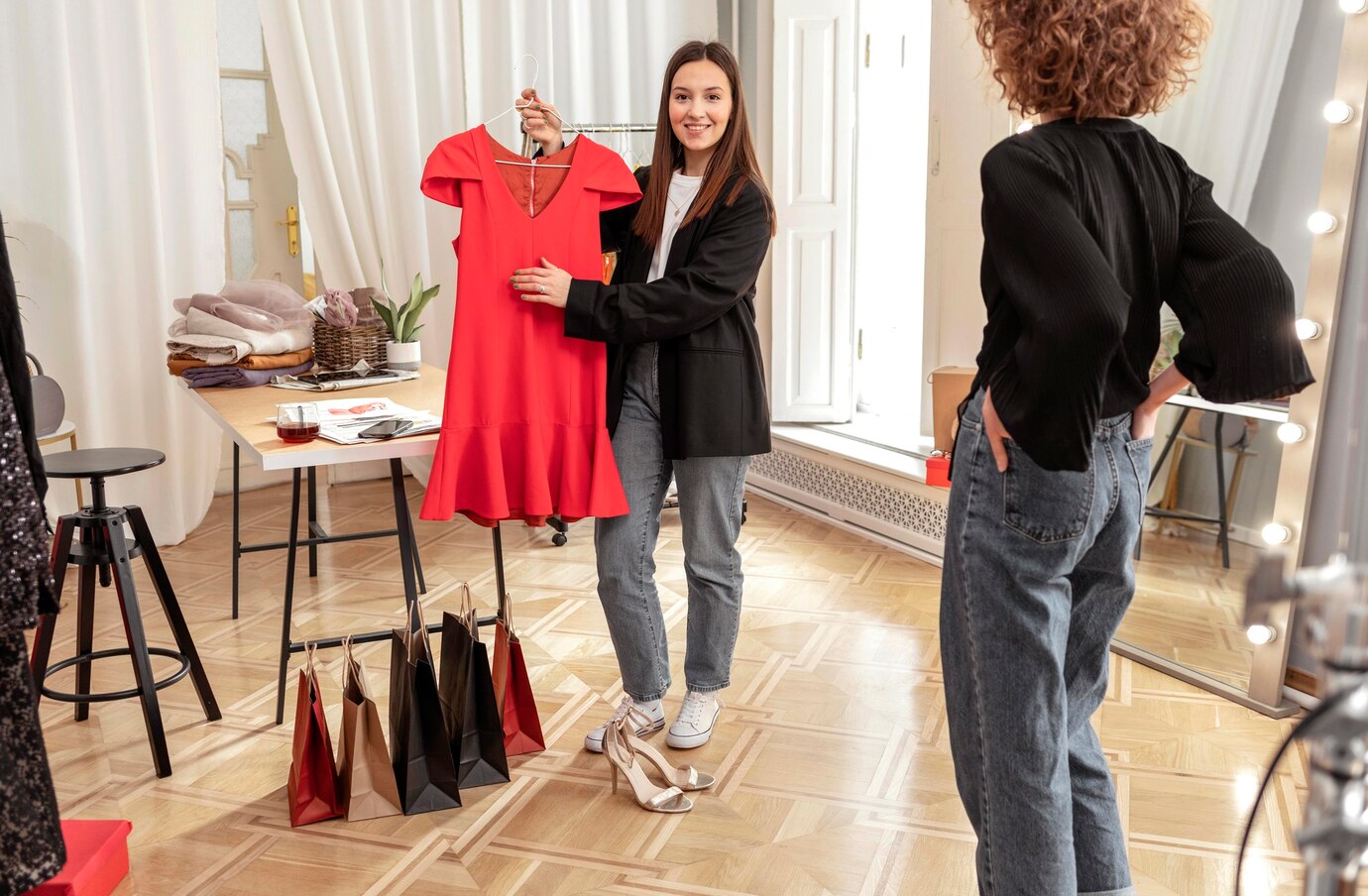
Picture this: You're sitting at your kitchen table at 11:47 PM, mindlessly scrolling through TikTok after what feels like the longest day of your life. Your thumb moves automatically, swipe, watch three seconds, swipe, pause for a cat video, swipe, suddenly you're learning how to fold fitted sheets from a complete stranger who somehow makes it look effortless.
Before you know it, it's 12:23 AM, and you've just spent 36 minutes in what I like to call "the scroll zone”, that magical place where time stops and your brain gets fed bite-sized pieces of entertainment, education, and pure randomness.
Sound familiar? If you're nodding your head right now, you're not alone. We've all been there. And if you're a business owner or marketer reading this, you're probably thinking, "How the heck do I get my brand into that scroll?"
Well, my friend, you've just stumbled upon the biggest marketing revolution since the internet went mainstream. Welcome to the wild, wonderful, and sometimes overwhelming world of short-form video advertising.
The Day Everything Changed (And We Didn't Even Notice)
I remember the exact moment I realized something fundamental had shifted in how we consume content. I was watching my 68-year-old mother, a woman who still asks me to "fix the WiFi" when Netflix is loading slowly, absolutely glued to her phone, giggling at a TikTok video of someone making pancake art.
"Mom," I said, "six months ago, you complained that YouTube videos were too long. Now you're watching cooking videos?"
She looked up with this guilty grin and said, "Well, they're actually useful!"
That's when it hit me. This isn't just about younger generations having short attention spans. This is about human behavior adapting to a world that moves faster than ever before. We're not becoming less intelligent or more impatient, we’re becoming more selective about where we invest our mental energy.
Think about your own day. You wake up, check your phone while coffee brews, scroll before your commute, steal moments between meetings, zone out after dinner. Our lives are full of these micro-moments, these tiny pockets of time that we fill with quick hits of content. And smart brands? They've figured out how to make those moments count.
Any experienced social media ad company will tell you, this shift isn't just about platforms changing their algorithms. It's about humans changing their habits, and that's infinitely more powerful than any algorithmic update.
Why Our Brains Are Literally Wired for This
Here's something that might blow your mind: the human brain processes visual information 60,000 times faster than text. But here's the kicker, we make decisions about whether we like something within the first 0.05 seconds of seeing it. That's faster than a blink.
So when someone says short-form videos are just a fad for people with short attention spans, they're missing the point entirely. This format works because it aligns perfectly with how our brains are designed to process information.
I was talking to a neuroscientist friend of mine last month (yes, I have neuroscientist friends, don't judge), and she explained it like this: "Imagine your brain is like a nightclub bouncer. It's constantly deciding what gets in and what gets rejected. Short-form videos are like the VIP pass, they look appealing, they don't ask for too much commitment, and they promise immediate gratification."
That's exactly what's happening when you watch a 30-second video about someone organizing their spice rack with military precision, or a quick tutorial on how to make your houseplants happy. Your brain says, "This looks interesting, it's not a huge time investment, and I might learn something useful. Let's do this."
The emotional payoff is instant. You laugh, you learn, you feel inspired, you get that tiny dopamine hit that makes you want to watch just one more. And another. And suddenly, you've watched 47 videos about home organization, dog training, and someone in Minnesota making elaborate sandwiches.
The Platforms That Changed Everything (And How They Did It)
Let's be real for a second. When TikTok first showed up, most of us older millennials rolled our eyes. "Great, another app for teenagers to dance on," we thought. Boy, were we wrong.
TikTok didn't just create another social platform, it created a new language. A way of communicating that transcends age, geography, and interests. I've seen a 45-year-old accountant making videos about tax tips that get more views than some TV commercials.
But here's what's really interesting: each platform developed its own personality, its own vibe, its own unspoken rules.
TikTok is like that friend who's always got something wild to show you. It's unpredictable, authentic, and it doesn't take itself too seriously. The algorithm is scary, good at knowing what you want to see, sometimes before you know it yourself. I once spent an entire Sunday watching people restore old furniture because TikTok somehow knew I was thinking about refinishing my grandmother's dining table.
Instagram Reels is like TikTok's more polished older sister. It keeps the short-form format but maintains that Instagram aesthetic we all secretly love. It's where brands can still look professional while being relatable. Perfect for that "aspirational but achievable" content that makes you think, "Maybe I could reorganize my entire life if I just had the right storage containers."
YouTube Shorts came into the game like, "Hold up, we've been doing video forever, let us show you how it's done." And honestly? They're not wrong. The integration with longer YouTube content creates this beautiful ecosystem where a 60-second Short can lead to a 20-minute deep dive, which is pure gold for brands trying to build genuine relationships with their audiences.
Even LinkedIn joined the party, and suddenly professional content got a lot more human. Seeing CEOs making videos about their morning routines or sharing behind-the-scenes glimpses of their companies? That's powerful stuff. It turns corporate entities into real people you might actually want to work with.
For any social media ad company trying to navigate this landscape, understanding these platform personalities isn't just helpful, it's essential. What works on TikTok might flop on LinkedIn, and what kills it on Instagram might feel too polished for TikTok.
The Stories That Keep Me Up at Night (In the Best Way)
Let me tell you about Sarah. Sarah owns a small bakery in Portland, and six months ago, she was struggling to keep the doors open. The pandemic had been brutal, foot traffic was down, and she was spending her evenings wondering if she should just give up on her dream.
Then her teenage daughter convinced her to start making TikTok videos showing how she decorates her custom cakes. Nothing fancy, just Sarah, her decorating tools, and whatever song was trending that week.
The first few videos got maybe 50 views each. Sarah was ready to quit. But her daughter said, "Mom, just keep going. You're amazing at this, and people need to see it."
Video number eight went viral. Not Hollywood viral, but small-business-changing viral. 2.3 million views of Sarah turning a plain vanilla cake into a work of art while Taylor Swift played in the background.
The comments were incredible. "I need this cake for my daughter's birthday!" "Do you ship to Chicago?" "This is so satisfying to watch!" "You're so talented!"
Within two weeks, Sarah had orders booked out for three months. She had to hire two additional decorators. She went from struggling to survive to having a waitlist.
The best part was reading comments from people saying her videos made their day better. Parents thanked her for giving them ideas for their kids' birthdays. Other small business owners said her success inspired them to keep going.
That's the power of authentic short-form content. It's not just about selling products, it’s about connecting humans to humans in a way that feels real and meaningful.
Or take Marcus, a personal trainer in Detroit who started making 30-second workout videos in his tiny apartment gym during lockdown. No fancy equipment, no perfect lighting, just genuine helpful content delivered with humor and personality.
His first video was literally titled "Workouts for People Who Hate Working Out (Like Me Yesterday)." He talked about his own struggles with motivation, showed modifications for every exercise, and made fitness feel accessible instead of intimidating.
Fast forward eight months, Marcus has trained over 200 people virtually, launched his own fitness app, and speaks at conferences about authentic fitness marketing. But ask him about his proudest moment, and he'll tell you about the woman who commented that his videos helped her find the confidence to join a gym for the first time in 20 years.
These aren't just success stories, they’re reminders that behind every view, every like, every share, there's a real person looking for connection, value, or just a moment of joy in their day.
The Creative Rollercoaster (Buckle Up)
Creating short-form content is like being on an emotional rollercoaster while trying to solve a puzzle and tell a joke at the same time. You have literally seconds to grab someone's attention, deliver value, and leave them wanting more. No pressure, right?
I've watched grown marketers have complete meltdowns trying to figure out how to explain their B2B software solution in 15 seconds. I've seen creative directors spend hours debating whether the logo should appear at second 3 or second 5. It's simultaneously the most liberating and most terrifying creative challenge you can imagine.
But here's what I've learned after working with dozens of brands on their short-form strategies: the magic happens when you stop thinking like a marketer and start thinking like a friend sharing something cool.
The best short-form content feels like a conversation, not a commercial. It's that friend who always knows the best restaurants, the coworker who has the perfect organization tip, the neighbor who somehow makes everything look effortless.
I remember working with a tech startup that made project management software, not exactly the sexiest topic for social media. We spent weeks trying to create the perfect "professional" video explaining their features and benefits. It was boring. Soul-crushingly boring.
Then their CEO mentioned in passing that he started the company because he was terrible at managing his own projects and his wife threatened to leave him if he missed another anniversary.
"Wait," I said. "Tell me more about that."
Turns out, this incredibly successful entrepreneur was just as disorganized as the rest of us. He shared stories about showing up to client meetings on the wrong day, forgetting to pay contractors, and double-booking himself for three different conferences.
That became our content strategy. Not "Revolutionary Project Management Software" but "Confessions of a Chronically Disorganized CEO." We made videos of him showing his chaotic calendar, his wife rolling her eyes at his sticky-note system, and him celebrating when he actually remembered to follow up on a lead.
The response was incredible. Comments poured in from other entrepreneurs saying, "Finally, someone who gets it!" Customers started sharing their own organization disasters. The software sales increased because people felt like they were buying from someone who understood their struggles, not some perfect productivity guru.
The Algorithm Dance (And Why It's Not As Scary As You Think)
Everyone talks about "the algorithm" like it's this mysterious, all-powerful entity that randomly decides the fate of your content. But here's the thing, algorithms aren't magic. They're just really sophisticated systems designed to show people content they'll enjoy.
Think of the algorithm as a really attentive party host. It watches how people react to different conversations, notices what makes them light up, what makes them stick around, what makes them want to join in. Then it introduces people to conversations it thinks they'll enjoy.
The algorithm rewards content that people actually engage with. It's looking for videos that make people watch until the end, that inspire comments and shares, that make people come back for more. In other words, it rewards good content that provides real value to real people.
I love explaining this to clients because it takes the pressure off trying to "hack" the system and puts the focus back on creating stuff people actually want to see. You can't trick the algorithm into promoting boring content, but you can create content so genuinely interesting that the algorithm can't help but show it to more people.
Working with a skilled social media ad company means having partners who understand this dynamic, who can help you create content that both serves your business goals and provides genuine value to your audience.
The Numbers That Made Me Believe
I used to be skeptical about short-form videos. I thought it was just a fad, that people would eventually crave longer, more substantial content again. Then I started paying attention to the data, and honestly? It changed everything.
Here are some numbers that made me a true believer:
Users spend 95 minutes per day on TikTok. That's more time than most people spend eating meals. Instagram Reels get 67% more engagement than regular video posts. YouTube Shorts are getting 30 billion views daily. But here's the stat that really got me: 73% of consumers prefer learning about products through short videos rather than reading text or watching long-form content.
But beyond the big numbers, it's the personal stories that really drive it home. Like the local restaurant that went from 12 customers on a slow Tuesday to having a line out the door after one TikTok video of their chef making their signature sandwich. Or the handmade jewelry designer who sold six months of inventory in two weeks after a single Instagram Reel showing her creative process.
These aren't flukes or lucky breaks. They're the result of understanding that in our hyperconnected, time-pressed world, the brands that can deliver value quickly and authentically are the ones that win.
The Human Side of the Screen
Here's what keeps me passionate about this industry: behind every metric, every view, every engagement, there's a person. Someone looking for connection, information, entertainment, or just a brief escape from whatever they're dealing with.
When we create short-form content, we're not just trying to sell products, we're trying to add a little value to someone's day. Maybe we can make them laugh during a tough morning. Maybe we can teach them something that makes their evening cooking more enjoyable. Maybe we can show them something beautiful that makes them feel inspired.
I think about the mom scrolling during her lunch break at a job she doesn't love, finding a 30-second video that reminds her of her dreams. Or the college student stressed about finals, stumbling across content that makes them laugh out loud in the library. Or the entrepreneur working late, discovering a quick tip that might just solve a problem they've been wrestling with for weeks.
That's the real power of short-form video. It's not about the technology or the algorithms or the marketing strategies. It's about human connection in tiny, perfect moments.
What This Means for Your Brand (The Real Talk)
If you're a business owner reading this, you're probably thinking one of two things: either "This sounds amazing, how do I get started?" or "This sounds overwhelming, where do I even begin?"
Both reactions are completely valid. Short-form video can feel like learning a new language while riding a bicycle on a tightrope. But here's the thing, every brand that's winning at this started exactly where you are right now.
The key is to start with authenticity. Don't try to be TikTok famous overnight. Don't obsess over production value or perfect lighting. Start by sharing your story, your expertise, and your personality in bite-sized pieces.
If you're a dentist, maybe share quick oral health tips. If you own a plant shop, show people how to keep their fiddle leaf fig alive. If you're a financial advisor, translate complex concepts into simple, actionable advice.
The goal isn't to go viral (though that's a nice bonus). The goal is to build genuine connections with people who might become customers, advocates, or just fans of what you do.
The Future Is Now (And It's Pretty Exciting)
We're living through one of the biggest shifts in marketing history, and honestly? I can't wait to see what comes next.
Virtual reality elements are starting to show up in short-form content. AI tools are making sophisticated video editing accessible to everyone. Live streaming is merging with short-form formats in interesting ways. The possibilities feel endless.
But at the core, it's still about the same thing it's always been about: telling stories that matter to people who care. The tools are just getting better, faster, and more accessible.
The brands that will thrive in this new landscape are the ones that understand that short-form video isn't just a marketing tactic, it's a way to build genuine relationships with customers at scale.
Why We Do What We Do
At MediaNug, we've had the privilege of watching hundreds of brands find their voice in the short-form video space. We've celebrated viral moments and learned from complete flops. We've seen tiny businesses become household names and watched established brands rediscover their humanity.
But what drives us every day isn't the metrics or the success stories, it's the knowledge that we're helping brands create genuine connections with real people. In a world that often feels impersonal and overwhelming, we're part of creating content that makes people feel seen, understood, and valued.
Every time a client tells us their video helped someone's day get a little better, every time we see authentic engagement that leads to meaningful business growth, every time we watch a brand discover the joy of showing their true personality, that's why we do this work.
Our vision at MediaNug is simple but powerful: we believe every brand has a story worth telling and an audience waiting to hear it. In this age of short-form video, we're here to help you tell that story in ways that matter, to people who care, in the brief but meaningful moments that define our digital lives.
The future of marketing isn't about who can shout the loudest or spend the most money. It's about who can create the most genuine connections, one 30-second video at a time. And honestly? That future is pretty exciting.
Frequently Asked Questions
1. What is considered short-form video content for social media advertising?
Short-form video content refers to videos that are typically 60 seconds or less in duration, designed specifically for social media platforms like TikTok, Instagram Reels, YouTube Shorts, and LinkedIn video posts. These videos are optimized for mobile viewing and created to capture attention quickly, deliver value efficiently, and encourage immediate engagement. Most successful short-form videos range from 15 to 30 seconds, with the first 3 seconds being crucial for grabbing viewer attention and preventing them from scrolling past your content.
2. How much does short-form video advertising cost compared to traditional social media ads?
Short-form video advertising costs vary significantly based on platform, targeting, and production quality, but generally offer better ROI than traditional ads. On TikTok, CPM rates range from $10-50, while Instagram Reels typically cost $0.20-2.00 per click. The key advantage is organic reach potential - a well-crafted short-form video can achieve viral distribution without paid promotion. Production costs are also lower, often requiring just a smartphone and basic editing software, compared to traditional commercials that may cost thousands to produce.
3. Which social media platforms are best for short-form video marketing in 2025?
The top platforms for short-form video marketing in 2025 are TikTok (leading engagement rates, especially for Gen Z and millennials), Instagram Reels (best for lifestyle and visual brands), YouTube Shorts (ideal for educational content and SEO benefits), and LinkedIn (perfect for B2B and professional content). TikTok offers the highest viral potential, Instagram Reels provides polished aesthetic appeal, YouTube Shorts integrates with longer content strategies, and LinkedIn video humanizes B2B brands effectively.
4. What are the key elements of a successful short-form video ad?
Successful short-form video ads contain five essential elements: a compelling hook within the first 3 seconds, clear value proposition or entertainment factor, authentic storytelling that feels native to the platform, strong visual appeal optimized for mobile viewing, and a clear call-to-action. The most effective videos follow a simple structure: grab attention immediately, deliver valuable content in the middle, and end with a memorable payoff or next step for viewers to take.
5. How do algorithms affect short-form video advertising reach and engagement?
Social media algorithms prioritize short-form videos that generate high engagement rates, completion rates, and rewatches. The algorithm analyzes viewer behavior within the first few hours of posting to determine broader distribution. Key factors include watch time percentage, comments, shares, saves, and how quickly engagement occurs after posting. Videos with 70%+ completion rates and strong early engagement typically receive wider organic reach, making algorithm optimization crucial for maximizing advertising ROI without increased spending.
6. What is the average ROI for short-form video advertising campaigns?
Short-form video advertising typically delivers 25-40% higher ROI compared to traditional social media advertising formats. Studies show that short-form videos generate 2.5x more engagement than longer videos and 67% more engagement than static posts. Successful campaigns often see cost-per-acquisition rates 20-30% lower than other digital advertising methods, with some viral campaigns achieving organic reach worth millions in traditional advertising spend for minimal production costs.
7. How long should short-form video ads be for maximum engagement?
The optimal length for short-form video ads is 15-30 seconds across most platforms, with 15-second videos showing the highest completion rates. TikTok videos perform best at 21-34 seconds, Instagram Reels at 15-30 seconds, and YouTube Shorts at 15-60 seconds. However, the first 3 seconds are most critical - if viewers don't engage within this timeframe, they typically scroll past. The key is delivering your core message within the first 8-10 seconds while maintaining interest throughout.
8. What equipment do I need to create professional short-form video ads?
Professional short-form video ads can be created with minimal equipment: a smartphone with good camera quality, stable lighting (natural light or a ring light), a tripod or stabilizer for steady shots, and basic editing software like CapCut, InShot, or Adobe Premiere. Most successful short-form videos prioritize authenticity over high production value, meaning expensive equipment isn't necessary. Good audio quality is more important than perfect visuals - consider investing in an external microphone for better sound.
9. How do I measure the success of short-form video advertising campaigns?
Success metrics for short-form video campaigns include engagement rate (likes, comments, shares), completion rate (percentage who watch to the end), click-through rate to your website or landing page, conversion rate from video viewers, cost per acquisition, and brand awareness lift. Platform-specific metrics like TikTok's "shares to views ratio" and Instagram's "saves rate" are also crucial. Most social media ad companies recommend tracking both vanity metrics (views, likes) and business metrics (leads, sales) to measure true campaign effectiveness.
10. Can small businesses compete with large brands in short-form video advertising?
Yes, small businesses often outperform large brands in short-form video advertising due to their ability to be more authentic, agile, and personal. The algorithm doesn't favor big budgets - it favors engaging content. Small businesses can leverage their personal stories, behind-the-scenes access, and direct customer relationships to create more relatable content. Many successful small business campaigns achieve viral reach with minimal budgets by focusing on genuine value, local community engagement, and an authentic brand personality that resonates with audiences more than polished corporate content.





